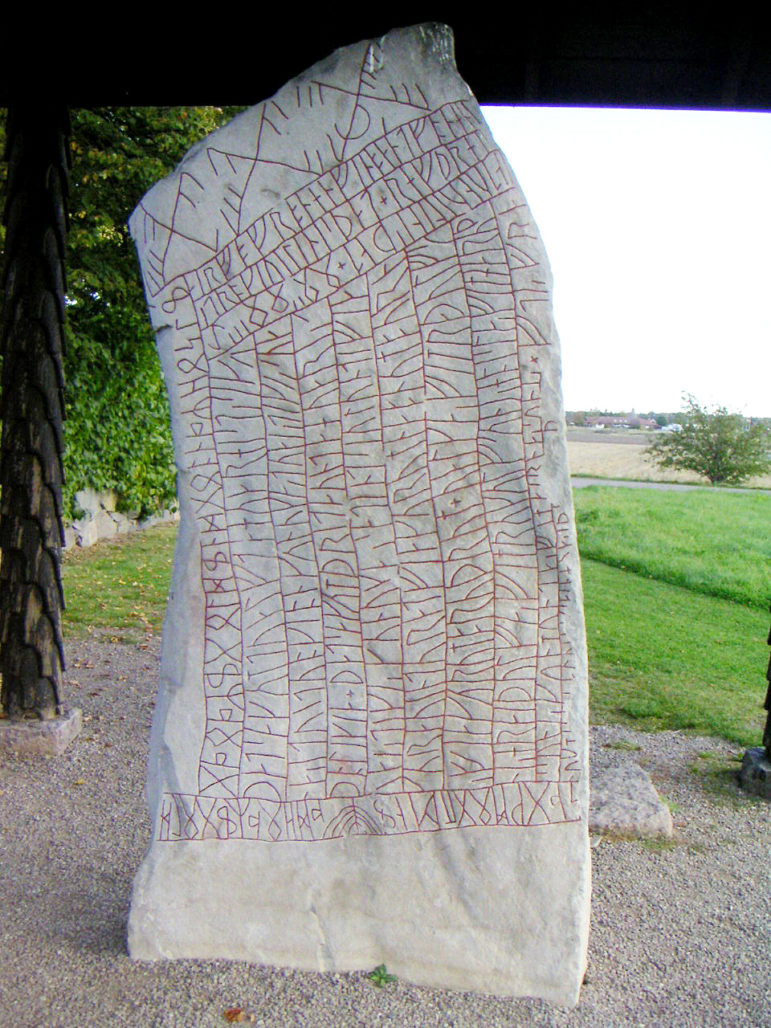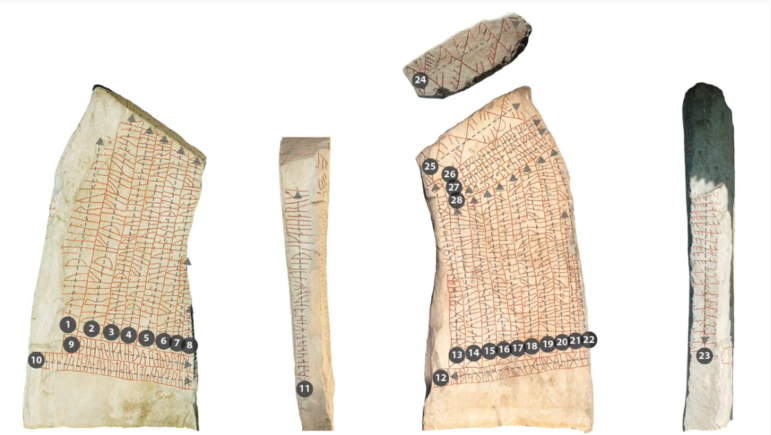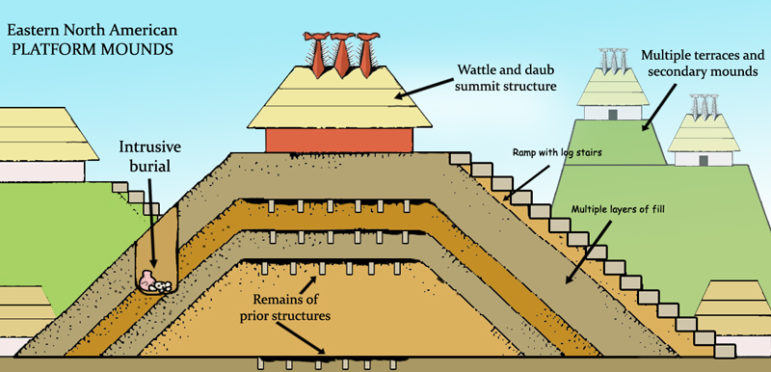TWH – This month’s Uncovering the Past reports on two discoveries, both challenge previously held beliefs.
A new interpretation of a runestone seeks to link it to Ragnarök and volcanic winters, beginning in 536 C.E.
Another new interpretation of evidence shows the possible survival of Native American ritual culture well past initial contact with Europeans.
The Rök Runestone
The Rök Runestone is located about halfway between Gothenburg and Stockholm, Sweden. The granite slab, is 2.5 m tall (roughly 8 ft), and weighing approximately five tons, it stands taller than most other runestones. Norse Pagans inscribed those runes around 800 C.E., centuries before Christianity became dominant.

Rök Runestone – Image credit: Bengt Olof ÅRADSSON – CC BY 1.0
Its inscription runs for 28 lines, one of which shows damage. Twenty lines are vertical. Eight are horizontal. About 700 runes are inscribed on the stone. It may be the longest known runic inscription.
Unfortunately, no one knows the order in which someone would read the runes. The text runs in multiple directions and includes cipher runes. The inscription mixes short twig runes with older futhark runes.

Reading directions for the 28 text rows of the Rök Runestone extracted from the source video, by the Swedish National Heritage Board – Image credit: Bengt A Lundberg, Swedish National Heritage Board – CC BY 4.0
Despite 150 years of academic study, no consensus has emerged about its meaning. This new interpretation of Holmberg, Gräslund, Sundqvist, and Williams raises the number of academic interpretations to sixteen.
Holmberg and colleagues’ interpretation links this runestone to Ragnarök. This interpretation also links it to Norse oral traditions, and from those oral traditions, the Eddas and skaldic poetry emerged.
Holmberg and colleagues’ interpretation challenges the dominant narrative, which links the Rök Runestone to Theodoric the Great (454 to 526 C.E.), King of Visigoths and of Italy. Instead, the scholars link the Rök Runestone to the mythic Ragnarök and the long volcanic winters from 536 to 550 C.E.
Several volcanic eruptions beginning in 536 C.E led to extended volcanic winters. Summers were abnormally cold from 536 to 550 C.E. throughout the Northern Hemisphere. Crop failure, disease, and famine would have been frequent. According to Holmberg and colleagues, the population of Scandinavia dropped by 50% during this period.
Holmberg and colleagues describe their interpretation in an article and present the original runic text. It contains a transliteration of those runes into the Roman alphabet. At this point, it is still in Old Norse, then present a translation of that old Norse into English.
After Vāmōðʀ, stand these runes. And Varinn, the father, made them after the death doomed son.
Let us say this as a memory for YggR, which spoils of war, there were two, which twelve times were taken as spoils of war, both from one to another?
This let us say as second, who nine generations ago lost their life with the Hraiðgutaʀ [i.e. in the east]; but still decides the matter?
Ride the horse did the bold champion, chief of men, over the shores of the Hraiðsea [i.e. over the eastern horizon]. Now he sits armed on his horse, his shield strapped, foremost of the famous.
Let us say this as a memory for Yggʀ, who because of a howler [i.e. wolf] has suffered through a woman’s sacrifice?
This let us say as twelfth, where the horse of the battle [i.e. the wolf] sees food on the battlefield, where twenty kings lie?
This let us say as thirteenth, which twenty kings were at the Grove of Sparks [i.e. the battlefield] in four directions, of four names, born of four brothers?
Five Valkis, sons of Rāðulfʀ, five Hraiðulfʀs, sons of Rōgulfʀ, five Hāā̃īsls, sons of Haruðʀ, five Gunnmundʀs, sons of Bern. And for Yggʀ a m(emory) …
Let us say a memory for Yggʀ, dare!
[Who is] a protector of sanctuaries for a brother?
[Whom] does the ravager [i.e. the wolf] redden with blood?
Let us say a memory for Yggʀ,
to whom is born an offspring, to the young man! It is not a lie.
[Who] could beat a giant? It is not a lie.
Clash!
The text includes a reference to events nine generations before the inscription. Assuming 30 years per generation, nine generations prior to the inscription would yield a date of 530 C.E. That date lies between the death of Theodoric the Great in 526 and the volcanic eruption of 536 C.E.
The reduced sunlight and cold in Scandinavia from 536 to 550 C.E. would have caused the social organization to change. Holmberg and colleagues reported that society became more stratified and militaristic, with the new elite focused strongly on Odin in his warrior aspect.
Holmberg and colleagues argue that the volcanic winter of 536 to 550 C.E. amplified beliefs about Ragnarök. In the “Vafþrúðnismál,” a period of extreme cold preceded Ragnarök.
Holmberg and colleagues also argue that events from 775 to 810 C.E. had parallels to the volcanic winters of 536 to 550 C.E. In 775 C.E., strong solar storms turned the sky red, and that summer was particularly cold.
An almost total solar eclipse occurred in 810 C.E. A key event in Ragnarök involves the wolf, Fenrir, swallowing the sun. That ingestion could describe solar eclipses and reduced sunlight of the volcanic winter.
These events could have triggered collective memories of the volcanic winters of 536 to 550 C.E. These overtones may have formed the mythic context in which King Varinn tried to make sense of the death of his son, Vāmōðʀ.
New interpretation of the inscription
Like other runestones, this one commemorates a death. Specifically, A father, Varinn, created it for Vāmōðʀ, his “death doomed son.” Holmberg and colleagues described this runestone’s purpose as placing “the death of his son in a meaningful context of eschatological events.” It also reflects the world view of the warrior elite.
Written as a series of memories, it has an elegiac tone. It includes nine enigmatic questions. In the Holmberg and colleagues’ interpretation, five questions concern the sun and four concern Odin.
According to these scholars, the exchange of “the spoils of war” refers to the daily exchange of lunar and solar light.
The inscription refers to the sacrifice of a woman to a wolf. In the myth of Ragnarök, Fenrir attacks the sun who had just given birth to a daughter who becomes the new sun. The woman sacrificed to the wolf would be the old sun who has just given birth. Generally, that is interpreted as the beginning of a new cycle. Holmberg and colleagues interpret it to also mean the return to normal weather after the year-long volcanic winters of 536 to 550.
The twenty kings refer to Odin’s warriors. Vāmōðʀ’s death has meaning as he will join those warriors and fight for Odin in Ragnarök. The inscription ends with a cipher for battle.
If Holmberg and colleagues’s interpretation is correct, it shows ancient Norse Pagan culture adapting to historic events and gradually changing over time.
Cultural Survival of Mound Builder Culture
In an article published in the Cambridge University Press, Jacob Holland-Lulewicz, Victor D. Thompson, James Wettstaed, and Mark Williams have challenged the dominant narrative of the collapse of mound builder culture in the Oconee Valley around 1550 C.E.

Diagram showing the various components of platform mounds constructed by Native Americans in the eastern United States. Image credit: Herb Roe, CC BY-SA 3.0
The dominant narrative relies on the absence of European material goods in the mound complex, except for one glass bead. Holland-Lulewicz and colleagues argue that indigenous people continued to hold rituals on the mound until 1670.
Holland-Lulewicz and colleagues base their challenge on improvements in dating technology and sophisticated statistical modeling. Improved dating techniques show continuous use of the mound up to 1670.
Holland-Lulewicz and colleagues also found parallels from the Dyar Mound with living Muscogee Nation traditions. Descendants of the Oconee mound builders became part of the Muscogee Nation. Current Muscogee ritual practice frequently bans industrial and “tech” products in ritual space. This would explain the absence of European artifacts in the remains of the mound.
The Dyar mound stood in the Oconee Valley of the north-central Piedmont region of Georgia. It had a height of about a three-story building. In the late 70s, archaeologists excavated the mound as part of a salvage operation, since the valley was slated to be flooded to create a reservoir.
The mound now lies under the reservoir. Holland-Lulewicz and colleagues re-analyzed material from that excavation.
Native Americans had built up the Dyar mound over centuries. On its top were two large platforms and a pergola.
A pergola is an Italian word derived from Latin defined in English as a “structure usually consisting of parallel colonnades supporting an open roof of girders and cross rafters.”
One platform had food scraps and cooking fires. The other had clay hearths for simmering liquids. According to Holland-Lulewicz and colleagues, today’s Muscogee Nation people have two foci in their ceremonial space.
Rather than total collapse following first contact with Europeans, Holland-Lulewicz and colleagues argue for a sustained cultural resistance for over 100 years.
The Wild Hunt is not responsible for links to external content.
To join a conversation on this post:
Visit our The Wild Hunt subreddit! Point your favorite browser to https://www.reddit.com/r/The_Wild_Hunt_News/, then click “JOIN”. Make sure to click the bell, too, to be notified of new articles posted to our subreddit.